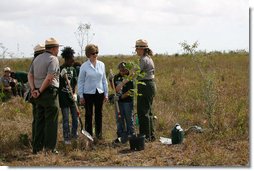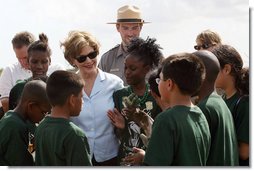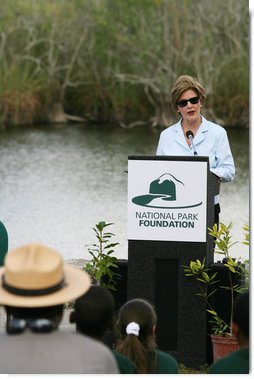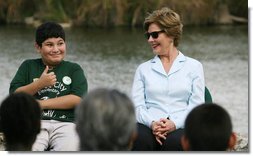|
Home >
News & Policies >
February 2008
|
For Immediate Release
Office of the First Lady
February 6, 2008
Mrs. Bush's Remarks at a Junior Ranger Event
Everglades National Park
2:22 P.M. EST
MRS. BUSH: Thank you, Ulises. Thank you very much. You can see he didn't need a speech after all. You are a terrific speaker. Thank you very much.
I hope that all of you will enter the contest, the essay writing contest that you just heard about from Vin Cipolla on what you can do to turn over a new leaf and take care of our environment, and especially the national parks. Ulises, I hope you'll be entering that essay contest, because I can tell you're a good writer.
 I also want to acknowledge Mary Bomar, the Director of the National Parks;
Dan Kimball, who is the Superintendent of Everglades and Dry Tortugas
National Parks. Thank you so much, Dan, for letting us being here today.
I also want to acknowledge Mary Bomar, the Director of the National Parks;
Dan Kimball, who is the Superintendent of Everglades and Dry Tortugas
National Parks. Thank you so much, Dan, for letting us being here today.
Mayor Lynda Bell has joined us, the Mayor of Homestead, Florida. Thank you, Mayor, for joining us today. Vin, thank you very much for everything you do for the National Park Foundation.
And now I'd like to recognize Regan Gammon, who is the Vice Chairman of the National Park Foundation. Where is she? There she is, right there. (Applause.)
I told these students -- a lot of these students are 5th-graders -- and I actually knew Regan before we were in the 5th grade. She's my lifelong friend, and she and I hike in the national parks every year. We started about 21 years ago hiking in the national parks. We started with the Grand Canyon, and then we've been in lots of beautiful parks. And so of course we're especially thrilled to be here today, together at Everglades National Park.
I also want to recognize a Ranger who's here, Ms. Lesley Sytsma. Lesley was the one who did our -- the Everglades National Park ornament that was on the Blue Room Christmas Tree in the White House this year. Thank you so much, Lesley. (Applause.)
And now, and especially, I want to recognize all the students who are here. We just had fun when we were over in a field planting native trees that will take over in those fields from the non-natives that have been there since the fields were plowed and farmed.
Farming techniques around the United States have left some land with non-native species in it, and we need to do everything we can -- and the Everglades is a great example of doing restoration of the native area, which not only brings the native animals back when the native plants come back, but it also uses less water. And in times of drought it's really important that we plant plants that are native, because they're the ones that are really suited for each part of the country.
While I'm here in Florida, I wanted to mention one thing about the tornadoes that came across the southern part of the United States yesterday. They were deadly tornadoes; we think about 44 people died. So I know that President Bush joins me and all of you in sending our sympathy and our love to the people of the states that lost people last night during the tornadoes.
 The President talked today to the governors of Alabama, Arkansas,
Tennessee, Kentucky and Mississippi, which is where those tornadoes were.
The President talked today to the governors of Alabama, Arkansas,
Tennessee, Kentucky and Mississippi, which is where those tornadoes were.
I'm so happy to be with you here today in your neighborhood national park, which also happens to be one of the most fabulous national parks in the world. There's no better place to experience America's national splendor than in our national parks. And you're very lucky to live so close to the Everglades. We especially want young people to get to enjoy the beauty and the pleasures of nature. Today, like Mary said, video games and television and the Internet are competing for children's attention, and we want to make sure that all American boys and girls get to get outside to breathe the fresh air and explore the beauty of our country.
There are 11 national parks in Florida -- 11 fabulous national parks. Here in Florida, the parks introduce young people to both natural and historical treasures. Children can go back in time and explore Spanish forts at Castillo de San Marcos National Monument and Fort Matanzas National Monument. At Canaveral National Seashore, young people can see where American explorers reach for new frontiers at the Kennedy Space Center. And at Biscayne National Park and Dry Tortugas National Park, visitors can experience the wonders of South Florida's underwater world. Marine animals also flourish in the marshes off the Gulf Islands National Seashore. And humans actually love the beautiful white beaches, white-sand beaches of that National Seashore.
The De Soto National Memorial in Bradenton commemorates the landing of Spanish explorer Hernando de Soto in 1539. And Florida's French colonial history is preserved at the Fort Caroline National Memorial. Just north of Fort Caroline, the Timucuan Ecological and Historical Preserve introduces visitors to more than 6,000 years of Native American history. And here in South Florida, visitors can hike or even ride airboats across the 720,000 acres of Big Cypress National Park.
But we're in one of the most fascinating national parks in the world: the Everglades. Everglades National Park protects more than one-and-a-half million acres, and it's the largest subtropical wilderness in the United States. The park contains artifacts representing centuries of human history, and it's been designated a World Heritage Site and an International Biosphere Reserve. Each year, nearly 15,000 students come to the Everglades for ranger-guided tours and special events.
 Everglades National Park is known for its amazing plants and birds, fish
and animals. The wetlands, forests and estuaries around us are home to
many rare and threatened species, including the Florida panther and the
American crocodile. Some of the Everglades' most fascinating plants and
wildlife, though, are threatened by what we call invasive species. These
are plants or animals that don't grow and live naturally in a region. But
once they're introduced to an area, they can grow quickly and then crowd
out native plants and animals.
Everglades National Park is known for its amazing plants and birds, fish
and animals. The wetlands, forests and estuaries around us are home to
many rare and threatened species, including the Florida panther and the
American crocodile. Some of the Everglades' most fascinating plants and
wildlife, though, are threatened by what we call invasive species. These
are plants or animals that don't grow and live naturally in a region. But
once they're introduced to an area, they can grow quickly and then crowd
out native plants and animals.
In the Everglades, there are hundreds of invasive plants and animals, and they cause a lot of trouble. Animals like wild pigs and armadillos are such good diggers that they're disturbing the park's archeological sites. Exotic trees like the Australian Pine increase the erosion of dunes in the Everglades, which disrupts the nesting of endangered sea turtles. Many exotic plants are crowding out native sawgrass prairie, which serve as a habitat that deer, apple snails, herons and alligators need to survive.
In the Everglades, National Park Service Exotic Plan Biologists work to remove soil containing exotic plant seed, and then to restore wetland that can support native plant life. You've been helping the Park Service biologists by restoring some of the native plants in the Everglades.
Planting native species is a great way to help our environment. The native plant conservation work you've done today is also part of First Bloom, a program which the National Park Foundation launched in October. First Bloom honors another First Lady who loved native plants: Lady Bird Johnson. She worked very hard to preserve native plants and wildflowers across the United States.
First Bloom is a partnership between the National Park Foundation and the Lady Bird Johnson Wildflower Center. First Bloom will let children come into their neighborhood national parks and work there to learn what are the native plants, to learn which plants are invasive, and then to help park biologists plant native plants. First Bloom will begin in five cities this year.
Encouraging young people to be good stewards of our environment is the goal of First Bloom, and it's also the goal of the Junior Ranger program. By planting native hardwoods in the Everglades today, all of the students here have just become Junior Rangers. So congratulations to each one of you.
 Through the Junior Ranger program, children across the United States can
learn about American history, because as you know, many of our national
parks are our American historical monuments, like the White House -- did
you know I live in a national park? -- (laughter) -- or the Washington
Monument or the Jefferson Monument or many, many more of our special
historical sites.
Through the Junior Ranger program, children across the United States can
learn about American history, because as you know, many of our national
parks are our American historical monuments, like the White House -- did
you know I live in a national park? -- (laughter) -- or the Washington
Monument or the Jefferson Monument or many, many more of our special
historical sites.
Last year, more than 400,000 children became Junior Rangers. You can also become a Junior Ranger online by going on Web Ranger. Web Rangers can visit park websites, can learn about parks, and complete activities online to earn badges.
We've just heard Vin introduce again the essay contest. I want to encourage all of you and all of American young people to enter the essay contest. Remember, the question is: What can you do now to turn over a new leaf for the environment and help preserve our national parks?
I hope you'll all participate in the essay contest. And in the meantime, I hope you've enjoyed turning over a new leaf here in the Everglades. Congratulations on becoming Junior Rangers, and good luck writing your essays. (Applause.)
END 2:33 P.M. EST


